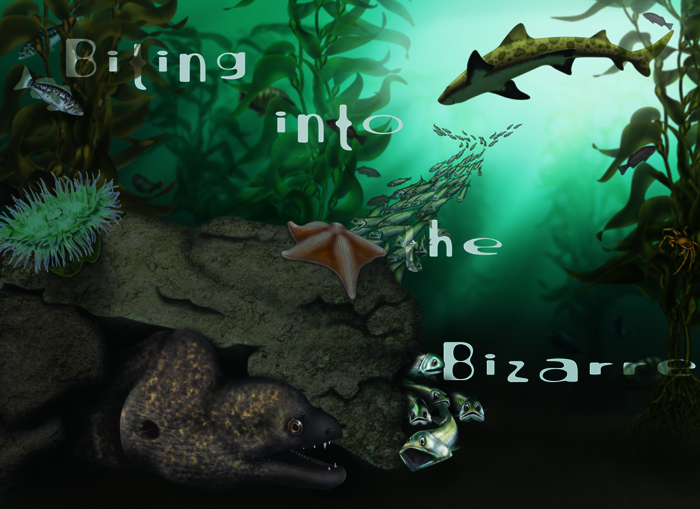
|
| Illustration: Jen Gillies |
Moray eels show there’s more than one way to snag a snack in the ocean. Molly Sharlach gets an up-close look. Illustrated by Jen Gillies and Adam Labuen.
A moray eel slinks about his tank. He's a bundle of muscle as thick as a human arm, covered with scaleless skin mottled beige and brown. His sole appendage, a dorsal fin, flaps from side to side as he swims in a sinuous wave. Every few seconds, he parts his jaws to breathe, revealing pointy, witch-like teeth. He withdraws into his den, a segment of PVC pipe—surely a second-rate substitute for the coral crevice on the seafloor where he used to live. He folds himself into half of his 3-foot length to settle in.
Ben Higgins approaches the tank. “Alright, Ice. Don’t let me down,” he says. Higgins, a graduate student at UC Santa Cruz, has thawed and carefully weighed portions of chow for each of the three California morays kept in a bare-bones room at Long Marine Laboratory. With a pair of forceps, Higgins lowers a squid the size of a hot dog into the tank, where it dangles at a safe distance above Ice’s hideout. Ice sniffs out the squid and spies it with his googly eyes.
It doesn’t take long for the moray to emerge. With a sudden lunge, his jaws swiftly part, then seize the morsel with formidable fangs. Ice bares his belly against the side of the tank, and the squid moves in a visible bulge down his throat. He retreats to lurk in his lair.
 This frenzied feeding belies a fine-tuned anatomical maneuver. An unusual second set of jaws allows the moray to make it as a crevice-dwelling predator. Higgins works with UCSC biologist Rita Mehta, who in 2007 was the first to capture the moray’s peculiar biting machinery on high-speed video. This frenzied feeding belies a fine-tuned anatomical maneuver. An unusual second set of jaws allows the moray to make it as a crevice-dwelling predator. Higgins works with UCSC biologist Rita Mehta, who in 2007 was the first to capture the moray’s peculiar biting machinery on high-speed video.
Mehta has a longstanding interest in animals that she calls “elongate limbless vertebrates.” She got her start studying how snakes squeeze their meals. “What do you do when you’re a long skinny muscle with no limbs whatsoever?” Mehta wonders. “I just think these extreme examples of animal feeding behavior are really, really exciting.”
Mehta and her research team have scrutinized hundreds of eel skulls. They’ve shown morays to be evolutionary oddballs, with skull structures distinct from those of other fish; some are unique even among eels. Their adaptations for grabbing large prey from crevices give them a singular status in the food web of coral reefs. But because morays hide out in rocky crannies and are active mainly at night, they’re tough to catch and track.
To learn how these predators digest their food, the team is now feeding captive morays. They are also working to trap and tag every moray along a mile-long stretch in southern California. Even in one of the world’s best-studied marine ecosystems, the morays remain a mystery that Mehta and her team have set out to solve.
Enigmatic eels
Though scientists have identified more than 800 eel species, many remain to be discovered, particularly in Pacific tropical reefs, where morays abound. “I have so many undescribed species sitting around here, it’s hard to keep track of them all,” says David G. Smith, an eel specialist at the Smithsonian’s National Museum of Natural History. “It’s incredible how much is out there, and how little we know about what’s out there, in spite of all the work we’ve done.”
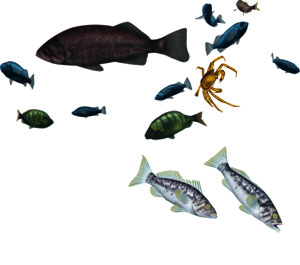 The 200 known species of morays span an impressive range of sizes. At less than five inches long, the Snyder’s moray is the smallest of the bunch. The most massive is the giant moray, which can grow up to 10 feet long and weigh 70 pounds. “I’ve seen them off the Big Island of Hawaii,” Higgins says. “It’s scary to see your study organism that big.” The California moray tops out at a more manageable five feet and weighs less than 12 pounds. The 200 known species of morays span an impressive range of sizes. At less than five inches long, the Snyder’s moray is the smallest of the bunch. The most massive is the giant moray, which can grow up to 10 feet long and weigh 70 pounds. “I’ve seen them off the Big Island of Hawaii,” Higgins says. “It’s scary to see your study organism that big.” The California moray tops out at a more manageable five feet and weighs less than 12 pounds.
Based on specimens he’s dissected, Higgins thinks the eels in the lab are about 15 years old, “but there’s a few assumptions in there.” Scientists determine the age of a fish by counting the growth rings of its inner ear bones, much like tree rings. But the growth patterns vary by species, and there’s no reliable reference point for morays. Higgins doesn’t know whether his research subjects are male or female, either—to find out, he would have to dissect them.
The moray’s secret weapon
Mehta’s foray into the world of morays began with their mysterious jaws. When it comes to feeding, all fish face a common predicament: How to generate enough force to catch prey that’s the same density as the surrounding water. For most, the power of suction does the trick. A series of tightly coordinated muscle movements rapidly expand the mouth, forcing a sudden drop in pressure that draws in the grub along with the water. Most fish catch their prey without even touching it—“like magic,” Mehta says.
The moray, though, has a different meal plan. Thanks to its long, narrow body, it can hide out in a dark cranny on the ocean floor, then dart out to ambush a tasty target. Morays usually capture whole prey, such as fish, shrimp and octopi—a challenge for these slim-headed predators. “You can’t suck a really large prey item,” says Mehta. “It would just be physically impossible.” Instead of suction, a powerful bite gets the job done.
Morays are not the only biters in the sea. Parrotfish rip off bits of coral to extract the algae within, while cleaner fish pick dead skin and parasites from the mouths of their obliging clients. Still, most biting fish rely at least partly on suction to deliver morsels into their mouths, and nearly all require the force of water to swallow. All fish have a second set of jaws that shear prey into consumable bits. The force of suction delivers the morsels to the throat, or pharynx, and then down the esophagus.
The “pharyngeal jaws” of morays sit unusually far back behind their heads. Mehta was not the first to notice this, but she may have been the first to grasp its implications in 2006, when she began working as a postdoctoral researcher with Peter Wainwright, a fish biologist at UC Davis. To study moray anatomy, she used a technique called clearing and staining. She soaked a preserved moray in an enzyme to degrade and clarify its flesh, and then used special stains that turn bone red and cartilage blue.
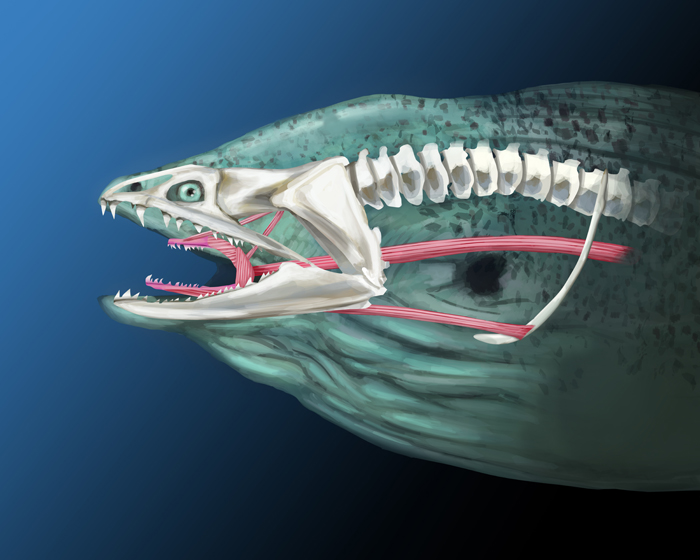 |
| Illustration: Adam Labuen |
“Neither one of us had ever seen a moray skeleton before,” Wainwright recalls. “The first thing that jumps out at you is this gigantic, bizarre pharyngeal jaw that doesn’t look like the pharyngeal jaw of any other fish. And within about 20 minutes of looking at that thing, just by intuition, we understood how it worked.” Still, it took two years to gather enough evidence to announce their new view of moray noshing.
Even by slowing down a moray’s feeding action with high-speed video, “it’s just very hard to get a really close look at what’s going on,” Wainwright says. “They move in unpredictable, wiggly ways.” But eventually, Mehta could see that after a moray’s initial chomp, the pharyngeal jaws lurched forward into the mouth to grasp the morsel and drag it down the esophagus. X-rays and dissections of moray heads showed the pharyngeal jaws were shaped like grasping arms. “They look like the oral jaws, but in the throat. They’re these long, toothy things,” Mehta says. In other fish, they look more like crushing plates.
Mehta used a scanning electron microscope to inspect the jaws’ backward-curving teeth, which reminded her of an eagle’s talons. Mehta and Wainwright described the moray’s “raptorial pharyngeal jaws” in a 2007 research paper. The report inspired comparisons to the “Alien” of the eponymous 1979 sci-fi horror flick. Mehta still keeps a pair of disembodied moray pharyngeal jaws in her office; she never knows when she might be called upon for a demonstration.
The diversity of biters
Now, Mehta and her team are expanding their grasp of weird and wondrous feeding adaptations. For biologists fascinated by how diversity evolved in the ocean, fish skulls are an ideal system, with more than 20 independently moving parts. (Humans have only one bone—our lower jaw—that moves when we eat.) And when it comes to feeding mechanisms, eels are an especially motley crew of biters and suction feeders.
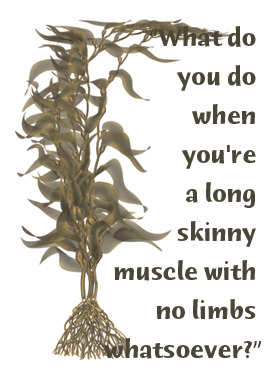 Feeding by suction requires a strict synchrony of skull parts. Mehta and postdoctoral researcher David Collar wondered whether biting eels, freed from these constraints, might be a more diverse bunch. To find out, they gathered specimens of 59 eel species. They measured 17 attributes of each skull, then looked for correlations among them. Feeding by suction requires a strict synchrony of skull parts. Mehta and postdoctoral researcher David Collar wondered whether biting eels, freed from these constraints, might be a more diverse bunch. To find out, they gathered specimens of 59 eel species. They measured 17 attributes of each skull, then looked for correlations among them.
Not surprisingly, suction-feeding species always had similar size relationships among different parts of the skull. But in biters, the proportions were all out of whack. This jibed with Mehta’s earlier observations of eel feeding: Morays, all biters, move their heads and jaws erratically, taking longer to capture prey than suction-feeding eels, with their precise oral choreography. The biters may be slower and sloppier, but they’re well adapted to snag large prey in tight spaces.
Collar and Mehta uncovered even more variation when they examined durophagous morays—those that crush hard-shelled prey, such as crabs and urchins, with their oral jaws. Compared to morays that feast on squishy squid, fish and octopi, durophagous species have shorter teeth packed into squatter jaws. Their meatier muscles generate fierce bite force—a kind of nutcracker suite ideal for cracking tough shells, as opposed to the forceps-like oral jaws of fish-eaters.
Biting isn’t the only factor in making a successful kill. Some morays also rotate and knot their bodies around their victims. Getting hold of a writhing piece of prey can be a whole-body affair.
Wild ways of the moray
Mehta and her team have a good handle on how morays devour prey. Now, they’re turning to wild morays to find out how these creatures really make a living. This work actually starts in the lab, where Ben Higgins has spent the past year examining the animals’ digestion.
Podcast produced by Molly Sharlach. Click on arrow to play.
Once a week, he offers each of three captive morays—Ice, Scout and (inexplicably) Number 2—five percent of its body weight in the form of squid, shrimp or anchovies. Higgins shoves tiny pieces of neon-colored tape into the grub. Two days later, he begins to check for “confetti poop” on the floor of each tank. “I’m getting a Ph.D. so I can make eel shit exciting,” he says.
Warmer water tends to quicken digestion. Shrimp and squid pass through a moray’s gut in about three days, while fish take five—suggesting they’re the richest in nutrients. Higgins will use these results to understand how many morays can thrive in a given patch of reef, and how much of a dent they might make in prey populations.
The experimental morays arrived in Santa Cruz two years ago in coolers on the back of a pickup truck after a seven-hour journey from Santa Catalina Island, 30 miles south of Long Beach. Along the coast of this popular tourist spot, the nooks and clefts of reefs and kelp beds conceal legions of free-range morays. The network of coves around the village of Two Harbors forms a natural laboratory for Mehta and her team, who spend several weeks each year tracking Catalina’s elusive morays.
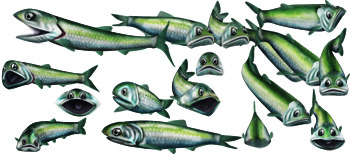 “There’s virtually nothing known about these things. I mean that in all senses,” Higgins says. “Particularly their ecological role, which is crazy, because they live in kelp forests, which are one of the more well-studied ecosystems in the ocean.” “There’s virtually nothing known about these things. I mean that in all senses,” Higgins says. “Particularly their ecological role, which is crazy, because they live in kelp forests, which are one of the more well-studied ecosystems in the ocean.”
“Quite often scientists only look at the visible species—the ones that are out and about that we see eating things,” says marine biologist Chris Lowe of California State University in Long Beach, an expert on sharks and game fish. “But it’s the hidden ones, the sneaky ones, that are probably having major effects, and we just don’t know what these are.”
During the field season, Mehta’s team scatters traps in coves and inlets every evening. Each double-chambered trap is the size of an extra-large microwave. The inner chamber holds the bait, a 20-ounce Gatorade bottle filled with anchovies and dotted with holes. When morays come out at night, some follow their noses into the traps, but can’t reach the bait. “No wonder they’re so angry when we pull them up,” Higgins says. The next morning, each trap yields several morays (as many as 13), sometimes biting each other or themselves as the team pulls the trap up onto the motorboat.
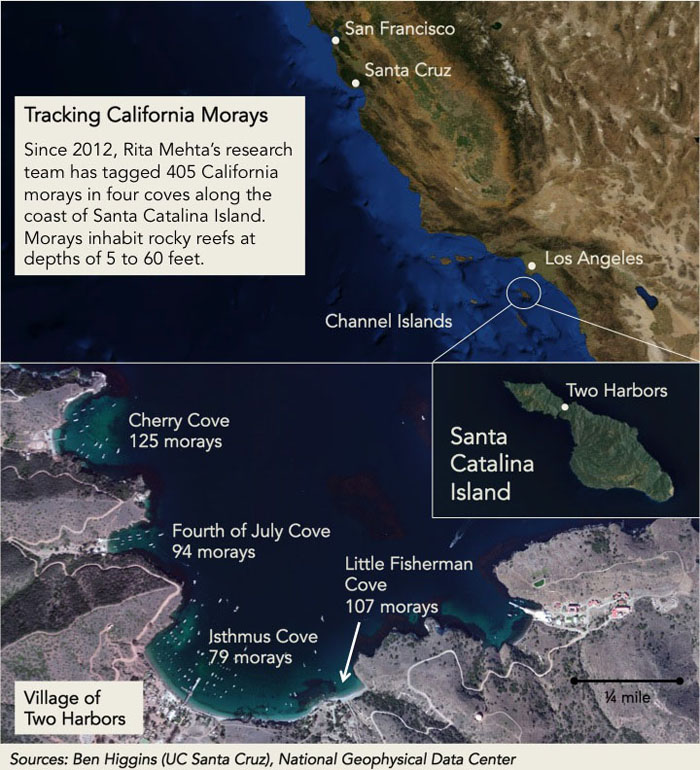 |
Graphic: Molly Sharlach |
| |
Then the crew of four or five goes into a flurry of activity. First, they immerse the morays in a bath of mild sedative. One team member acts as the anesthesiologist, taking care not to leave the animals in too long. After a few minutes, the patients are calm enough for their exams. The team records each individual’s length, weight, head size, and vertical gape distance, or how wide it can open its mouth—“That one’s the gnarliest one that we weren’t able to do before we started anesthetizing them,” Higgins says.
The gape distance, usually between two and three inches, determines how large a prey item a moray can eat. The only way to find out about its latest meal, says Higgins, is to take hold of the slimy animal and “slowly massage the food up and get them to regurgitate it.” Finally, one of the crew injects a scannable microchip ID—just like the ones in pet cats and dogs—into the moray’s muscle tissue, well away from its internal organs. This allows the researchers to find out whether they’ve already caught a moray and where, and how much it has grown.
This work is still in its early stages; a few more years’ worth of data will paint a picture of how the morays influence life on the reef. But so far, Mehta says, “We’ve tagged more than 400 morays in less than a mile of coastline. To me that’s really surprising.” She expected competing morays would need larger ranges to find enough food, “but it seems like I’m totally wrong about that.”
Mehta’s team has yet to catch a juvenile moray off Catalina, and suspects the population originates in Mexican waters. Few have witnessed morays mating. “It’s difficult because you have to be there just when they’re doing it,” says the Smithsonian’s David G. Smith. “They do it on their schedule.”
Though sharks, rays and bass rule the roost in open water, morays may sit atop the rocky reef food chain. Higgins thinks the morays pick up prey when sharks swim by. “The place to go if you’re being chased is where the shark can’t fit,” he says. “That’s exactly where morays are making their money. They’re in a very specific spot, which allows them to feed on anything that needs to hide in there.”
The team conducts diving surveys to gauge the available prey at various depths. Most overturned rocks reveal shrimp or abalone. But occasional underwater encounters with morays have given Higgins a healthy respect for their predatory powers. “Every now and then you’ll put your light in there and they’ll be staring right at you,” he says. “It’s a little startling.”
© 2014 Molly Sharlach / UC Santa Cruz Science Communication Program
Top
Biographies

Molly Sharlach
B.A. (biology and Russian) Williams College
Ph.D. (microbiology) University of California, Berkeley
Internship: Princeton University research magazine, The Scientist
My version of playing outside usually meant gazing at anthills or gathering seeds and leaves. Closely observing nature came instinctively to me. In the Connecticut woods, at the Bronx Zoo, and at the American Museum of Natural History, I was continually amazed by life's diversity. Later, I daydreamed about ribosomes, polymerases and mitochondria—the minuscule machines within my own cells.
As a graduate student, I had a ringside seat for the world’s tiniest tomato fight: a molecular competition between the plants and their bacterial adversaries. At the same time, a different conflict caught my attention. Even as scientists fine-tuned plant genes to create smarter crops, distortions of their efforts propagated fear of genetic engineering. Leaving behind my battles with microbes and molecules, I now gather explanations to take on the mysteries and misconceptions of science.
Molly Sharlach's website
. . . . . . . . . . . . . . . . . . . . . . . . . . . . . . . . . . . . . . . . . . . . . . . . . . .
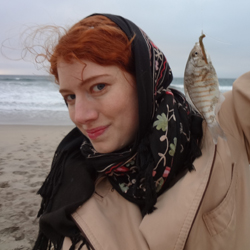 Jen Gillies Jen Gillies
B.A. (anthropology) Mary Baldwin College
I was born into a family of naturalists in a small town in West Virginia, with almost boundless opportunity to explore many of the rich natural habitats of the Appalachians. It may come as no surprise that I learned how to use a field guide before I learned how to read! After a childhood full of fossil hunting, insect collecting, tadpole hatching, and stone turning-over, as well as endless doodling, I entered college at age fourteen with dreams of majoring in biology (which were quickly abandoned when it became apparent just how many lab reports that entailed). I put both science and art aside to pursue other interests, but returned to them after graduating. These days, illustration has become a way to reclaim that childhood feeling of finding those natural treasures—a shed antler, an unusual seed pod or an intricately beetle-bored piece of bark—and a way to share those small wonders with others.
Jen Gillies's website
. . . . . . . . . . . . . . . . . . . . . . . . . . . . . . . . . . . . . . . . . . . . . . . . . . .
 Adam Labuen Adam Labuen
B.A. (studio arts) San Francisco State University
Internships: The National Tropical Botanical Gardens, Hawai’i; Smithsonian Institution; The Owl Research Institute, Montana; University of Kentucky Department of Biology
Born and raised in Palm Springs, CA, Adam was surrounded by the Coachella Valley’s rich wildlife. He took an appreciation to nature at an early age, hiking through the arid deserts and lush canyons. Throughout the years this admiration has led him to the path of a Science Illustrator. Adam works in traditional and digital media. He is skilled in acrylic, gouache, watercolor, and colored pencil. Digitally, he is versed in Photoshop, Illustrator, InDesign and After Effects.
Adam Labuen's website
Top |

